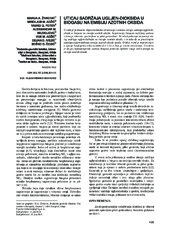Приказ основних података о документу
Uticaj sadržaja ugljen-dioksida u biogasu na emisiju azotnih oksida
Influence of carbon dioxide content in biogas on nitrogen oxides emissions
| dc.creator | Živković, Marija A. | |
| dc.creator | Adžić, Miroljub | |
| dc.creator | Fotev, Vasko | |
| dc.creator | Milivojević, Aleksandar | |
| dc.creator | Adžić, Vuk M. | |
| dc.creator | Ivezić, Dejan | |
| dc.creator | Ćosić, Boško D. | |
| dc.date.accessioned | 2022-09-19T16:28:02Z | |
| dc.date.available | 2022-09-19T16:28:02Z | |
| dc.date.issued | 2010 | |
| dc.identifier.issn | 0367-598X | |
| dc.identifier.uri | https://machinery.mas.bg.ac.rs/handle/123456789/1066 | |
| dc.description.abstract | U radu je prikazano eksperimentalno istraživanje i analiza uticaja sadržaja ugljen-dioksida u biogasu na emisiju azotnih oksida. Sagorevanje biogasa različitog sastava vršeno je vihornim gorionikom sa pilot gorionikom. Rezultati pokazuju da postoji uticaj sadržaja ugljen-dioksida na emisiju azotnih oksida, i to tako da sa povećanjem sadržaja ugljen-dioksida emisija azotnih oksida opada. Ovakav trend je nepromenjen u opsegu koeficijenta viška vazduha (1,2-1,8) za koje je vršeno istraživanje. Utvrđeno je da pri nepromenjenom sastavu biogasa promena toplotne snage nema uticaja na emisiju azotnih oksida. | sr |
| dc.description.abstract | Fuels derived from biomass are an alternative solution for the fossil fuel shortage. Usually fuels of this kind are called low calorific value fuels, due to the large proportion of inert components in their composition. The most common is carbon dioxide, and its proportion in biogas can be different, from 10 up to 40%, or even more. The presence of inert component in the composition of biogas causes problems that are related with flame blow off limits. One of the possibilities for efficient combustion of biogas is the combustion in swirling flow including a pilot burner, aimed to expand the borders of stable combustion. This paper presents an analysis of the influence of the carbon dioxide content on nitrogen oxides emissions. Laboratory biogas was used with different content of CO2 (10, 20, 30 and 40%). The investigation was carried out for different nominal powers, coefficients of excess air and carbon dioxide content. With increasing content of carbon dioxide, emission of nitrogen oxides was reduced, and this trend was the same throughout the whole range of excess air, carried out through measurements. Still, the influence of carbon dioxide content is significantly smaller than the influence of excess air. The coefficient of excess air greatly affects the production of radicals which are essential for the formation of nitrogen oxides, O, OH and CH. Also, the results show that the nominal power has no impact on the emission of nitrogen oxides. | en |
| dc.publisher | Savez hemijskih inženjera, Beograd | |
| dc.rights | openAccess | |
| dc.rights.uri | https://creativecommons.org/licenses/by-nc-nd/4.0/ | |
| dc.source | Hemijska Industrija | |
| dc.subject | sadržaj ugljen-dioksida | sr |
| dc.subject | biogas | sr |
| dc.subject | azotni oksidi | sr |
| dc.subject | nitrogen oxides | en |
| dc.subject | carbon-dioxidecontent | en |
| dc.subject | biogas | en |
| dc.title | Uticaj sadržaja ugljen-dioksida u biogasu na emisiju azotnih oksida | sr |
| dc.title | Influence of carbon dioxide content in biogas on nitrogen oxides emissions | en |
| dc.type | article | |
| dc.rights.license | BY-NC-ND | |
| dc.citation.epage | 445 | |
| dc.citation.issue | 5 | |
| dc.citation.other | 64(5): 439-445 | |
| dc.citation.rank | M23 | |
| dc.citation.spage | 439 | |
| dc.citation.volume | 64 | |
| dc.identifier.doi | 10.2298/HEMIND100614045Z | |
| dc.identifier.fulltext | http://machinery.mas.bg.ac.rs/bitstream/id/44/1063.pdf | |
| dc.identifier.scopus | 2-s2.0-78449281214 | |
| dc.identifier.wos | 000285175800009 | |
| dc.type.version | publishedVersion |


